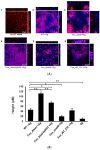Role of FAD-I in Fusobacterial Interspecies Interaction and Biofilm Formation
- PMID: 31906541
- PMCID: PMC7023056
- DOI: 10.3390/microorganisms8010070
Role of FAD-I in Fusobacterial Interspecies Interaction and Biofilm Formation
Erratum in
-
Correction: Shokeen, B., et al. Role of FAD-I in Fusobacterial Interspecies Interaction and Biofilm Formation. Microorganisms 2020, 8, 70.Microorganisms. 2020 Dec 29;9(1):63. doi: 10.3390/microorganisms9010063. Microorganisms. 2020. PMID: 33383978 Free PMC article.
Abstract
: RadD, a major adhesin of oral fusobacteria, is part of a four-gene operon encoding the small lipoprotein FAD-I and two currently uncharacterized small proteins encoded by the rapA and rapB genes. Previously, we described a role for FAD-I in the induction of human B-defensin 2 (hBD2) upon contact with oral epithelial cells. Here, we investigated potential roles for fad-I, rapA, and rapB in interspecies interaction and biofilm formation. Gene inactivation mutants were generated for each of these genes in the nucleatum and polymorphum subspecies of Fusobacterium nucleatum and characterized for their adherence to partner species, biofilm formation, and operon transcription. Binding to Streptococcus gordonii was increased in all mutant strains with Δfad-I having the most significant effect. This increased adherence was directly proportional to elevated radD transcript levels and resulted in significantly different architecture and height of the biofilms formed by Δfad-I and S. gordonii compared to the wild-type parent. In conclusion, FAD-I is important for fusobacterial interspecies interaction as its lack leads to increased production of the RadD adhesin suggesting a role of FAD-I in its regulation. This regulatory effect does not require the presence of functional RadD.
Keywords: Fusobacterium nucleatum; RadD; biofilm; fad-I; interspecies interaction.
Conflict of interest statement
The authors have no conflicts of interest to disclose.
Figures








Similar articles
-
Streptococcus mutans SpaP binds to RadD of Fusobacterium nucleatum ssp. polymorphum.Mol Oral Microbiol. 2017 Oct;32(5):355-364. doi: 10.1111/omi.12177. Epub 2017 Feb 13. Mol Oral Microbiol. 2017. PMID: 27976528 Free PMC article.
-
Identification and characterization of a novel Fusobacterium nucleatum adhesin involved in physical interaction and biofilm formation with Streptococcus gordonii.Microbiologyopen. 2017 Jun;6(3):e00444. doi: 10.1002/mbo3.444. Epub 2017 Feb 7. Microbiologyopen. 2017. PMID: 28173636 Free PMC article.
-
The Fusobacterium nucleatum outer membrane protein RadD is an arginine-inhibitable adhesin required for inter-species adherence and the structured architecture of multispecies biofilm.Mol Microbiol. 2009 Jan;71(1):35-47. doi: 10.1111/j.1365-2958.2008.06503.x. Epub 2008 Nov 7. Mol Microbiol. 2009. PMID: 19007407 Free PMC article.
-
Characterization of aid1, a novel gene involved in Fusobacterium nucleatum interspecies interactions.Microb Ecol. 2014 Aug;68(2):379-87. doi: 10.1007/s00248-014-0400-y. Epub 2014 Mar 20. Microb Ecol. 2014. PMID: 24643713 Free PMC article.
-
Genetic and molecular determinants of polymicrobial interactions in Fusobacterium nucleatum.Proc Natl Acad Sci U S A. 2021 Jun 8;118(23):e2006482118. doi: 10.1073/pnas.2006482118. Proc Natl Acad Sci U S A. 2021. PMID: 34074747 Free PMC article.
Cited by
-
Airway Fusobacterium is Associated with Poor Response to Immunotherapy in Lung Cancer.Onco Targets Ther. 2022 Feb 28;15:201-213. doi: 10.2147/OTT.S348382. eCollection 2022. Onco Targets Ther. 2022. PMID: 35250279 Free PMC article.
-
The Oral Microbiota: Community Composition, Influencing Factors, Pathogenesis, and Interventions.Front Microbiol. 2022 Apr 29;13:895537. doi: 10.3389/fmicb.2022.895537. eCollection 2022. Front Microbiol. 2022. PMID: 35572634 Free PMC article. Review.
-
Innovative strategies targeting oral microbial dysbiosis: unraveling mechanisms and advancing therapies for periodontitis.Front Cell Infect Microbiol. 2025 Apr 30;15:1556688. doi: 10.3389/fcimb.2025.1556688. eCollection 2025. Front Cell Infect Microbiol. 2025. PMID: 40370404 Free PMC article. Review.
-
Coaggregated E. faecalis with F. nucleatum regulated environmental stress responses and inflammatory effects.Appl Microbiol Biotechnol. 2024 May 18;108(1):336. doi: 10.1007/s00253-024-13172-9. Appl Microbiol Biotechnol. 2024. PMID: 38761182 Free PMC article.
-
Correction: Shokeen, B., et al. Role of FAD-I in Fusobacterial Interspecies Interaction and Biofilm Formation. Microorganisms 2020, 8, 70.Microorganisms. 2020 Dec 29;9(1):63. doi: 10.3390/microorganisms9010063. Microorganisms. 2020. PMID: 33383978 Free PMC article.
References
-
- Handley P., Rickard A. Coaggregation—Is it a universal biofilm phenomenon? In: Gilbert P., Allison D., editors. Biofilm Community Interactions: Chance or Necessity? Bioline; London, UK: 2001. pp. 1–10.
Grants and funding
LinkOut - more resources
Full Text Sources
Molecular Biology Databases

